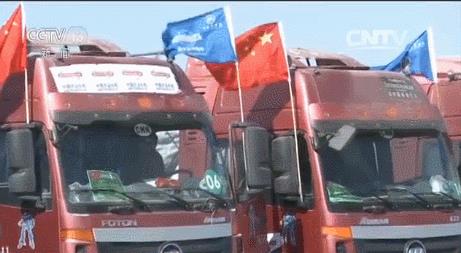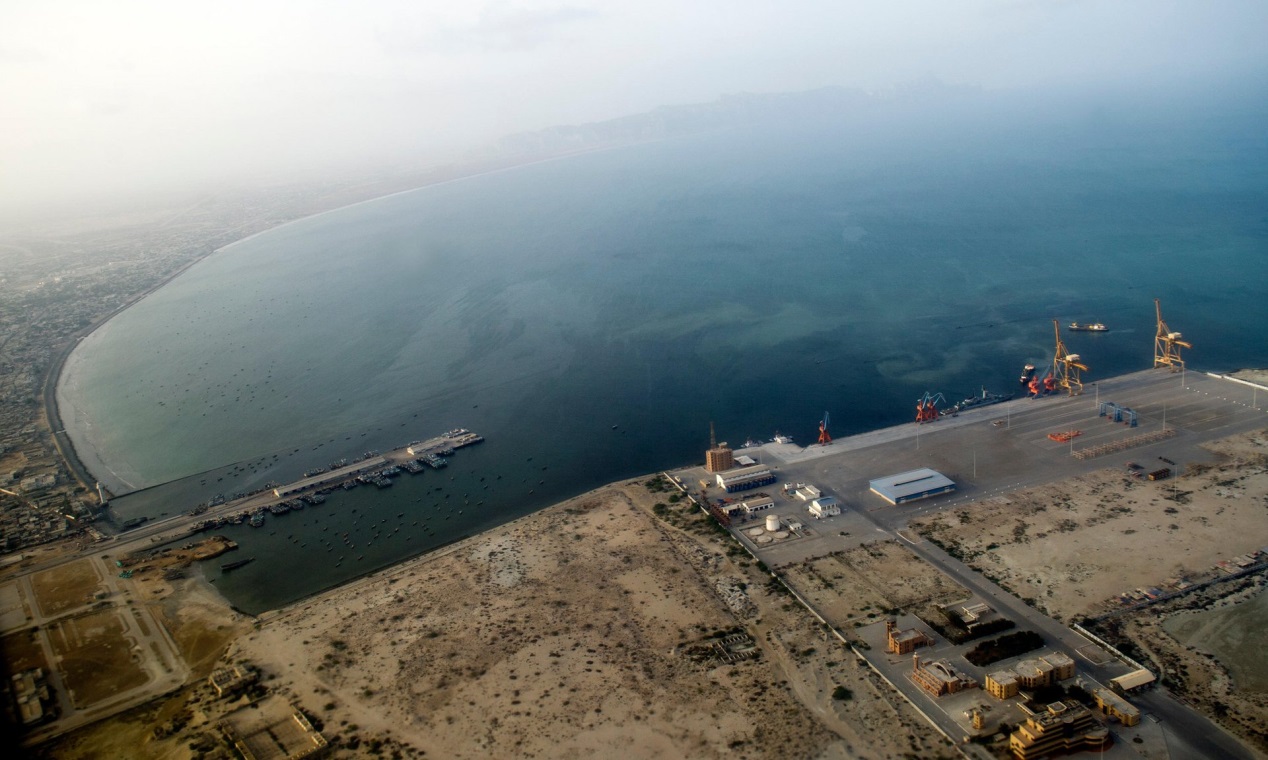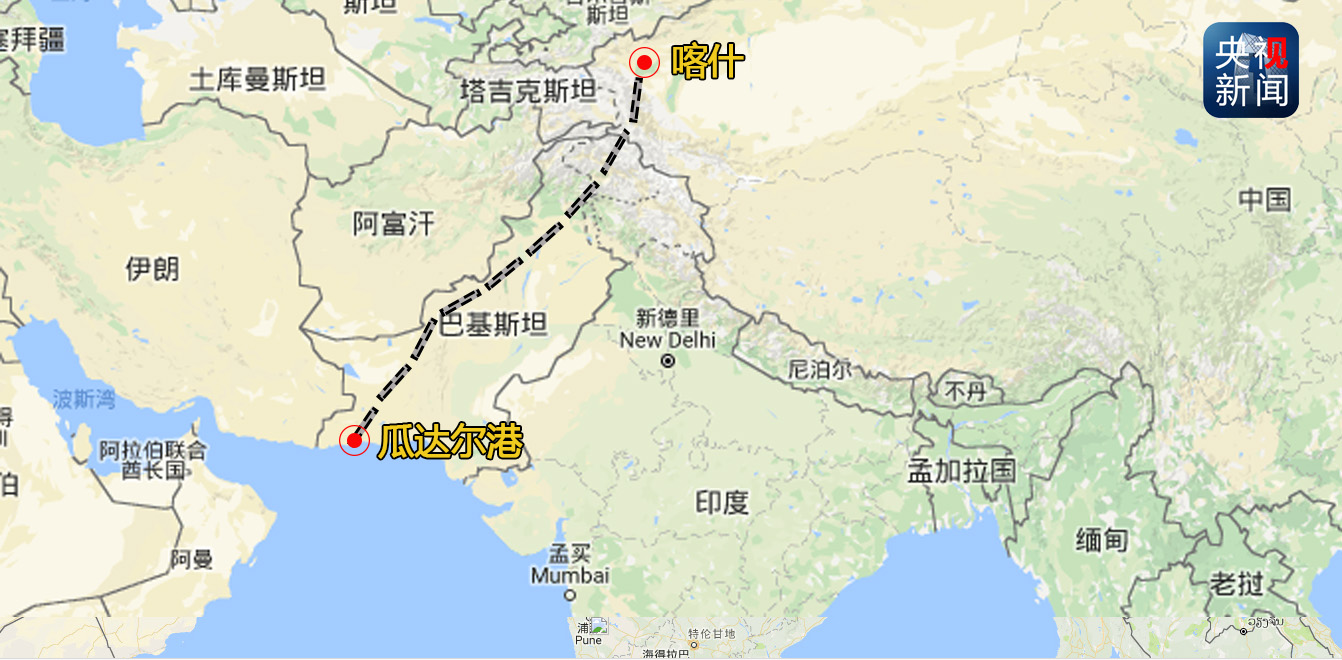CCTV News:On November 14th, CCTV news channel "News Live Room" broadcast a 1-minute and 20-second report, "Concerned about the construction of China-Pakistan Economic Corridor, the first joint trade convoy arrived in Gwadar Port". The report mentioned that the "China-Pakistan joint trade convoy" (consisting of about 50 trucks) departed from Kashgar, Xinjiang, China on October 29th, and crossed the western part of Pakistan from north to south, covering more than 3,000 kilometers. Fifteen days later, it arrived in Gwadar Port.

The first joint trade convoy arrived in Gwadar Port.

The first joint trade convoy arrived in Gwadar Port.
This report also broadcasts a picture of the dock full of containers waiting to go out to sea. The commentary is: Subsequently, the goods will be loaded with China freighters here and eventually shipped to countries such as the United Arab Emirates. The report said, "This is the first time that goods departing from China have been exported overseas through Gwadar Port, marking"China-Pakistan Economic Corridor" is becoming a reality from concept ".
This is not an ordinary transnational "driving tour". It is reported that a statement issued by the Pakistani government indicated that the first batch of China’s outbound convoys successfully arrived in Pakistan under strict security protection.
This event was officially called "the first trial connection activity of China-Pakistan Economic Corridor Joint Trade Team" by Pakistani Railway. At the ceremony held in Gwadar Port on the 13th, Sun Weidong, Ambassador of China to Pakistan, was invited to attend and deliver a speech. The people who attended the ceremony included: Pakistani Prime Minister, Pakistan Army Chief of Staff, Pakistan Navy Chief of Staff, and Pakistan Air Force Chief of Staff & HELIP; …
More than 600 people attended the whole ceremony.
China’s ambassador to Pakistan, Sun Weidong, said at the ceremony: This is the first time that a trade convoy has successfully crossed the western part of Pakistan from north to south. This shows that the local roads have achieved initial connectivity, and the concept of "one corridor and multiple channels" is gradually becoming a reality.
Pakistani Prime Minister Sharif’s speech said"Today marks the dawn of a new era".

Aerial panorama of Gwadar Port in 2014, image source: Guardian
Pakistan has leased 2,000 mu of land in Gwadar Port to the Chinese-funded China Overseas Port Holding Co., Ltd. for 40 years to build the first special economic zone in Gwadar Port. As a matter of fact, the construction of Gwadar Port has been attached great importance by western governments, media and think tanks since China began to lease this port.
Its special geographical location is one of the important reasons. According to a report in Liberation Daily, the geographical advantages of Gwadar Port can be seen at a glance: it is located in the southwestern border of Pakistan, on the Arabian Sea, close to the Iranian border, only 400 kilometers away from the Strait of Hormuz, the world’s main oil transportation channel, and comparable to the gateway to the Arabian Sea and the Persian Gulf.

Yang Xun, a Pakistani correspondent of People’s Daily, once wrote in a report entitled "China enterprises sign an operation agreement for Gwadar Port": China has made great contributions to the construction of Gwadar Port. In 2007, when Pakistani President Musharraf was in power, Singapore International Port Group won the right to operate Gwadar Port for 40 years. Some analysts believe that President Musharraf didn’t hand over the port operation right to China because he didn’t want to offend the United States. However, in the subsequent operation and management, the annual freight volume of the port is insufficient, and the operation is unsustainable. Most of the time, Gwadar Port is basically idle.
The Associated Press reported on November 13th that China ships are now sailing from Malacca Strait to Arabian Sea and Indian Ocean, and China has been looking for more convenient and reliable access to the sea. Gwadar Port is located along the Arabian Sea, occupying a strategic position between South Asia, Central Asia and the Middle East.
Pei Yuanying, the former ambassador to India, once told reporters that when China’s naval formations go to Suez Canal, the Mediterranean Sea and the Gulf of Aden to take part in anti-piracy cruises, Gwadar Port will become a logistics support base for the replenishment and maintenance of large fleets along the way.
Then, what exactly is Gwadar Port and why is it valued by Pakistan?
"Gwadar Port is like Shenzhen before the reform and opening up," Seddik Ur Rahman Rana, general manager of Pakistan Technology Exchange and Cooperation Company, once told China reporters.
China reporter once described Gwadar Port as follows: In March 2002, the reporter attended the groundbreaking ceremony of the first phase project of Gwadar Port between China and Pakistan and went to Gwadar. At that time, there was only one local airport capable of taking off and landing military aircraft, and it was about an hour’s drive to the port. Along the way, there are no mountains and deserts, and there is no grass color. Gwadar village is small and the traffic is inconvenient. The local media also called it a "desolate and stony" barren land.
The expression "Shenzhen in Pakistan" has also been quoted by western media such as Bloomberg, Guardian, etc. This once unknown port is looking forward to upgrading its appearance through infrastructure construction. British journalists once described this "Shenzhen before the reform and opening up": Gwadar Port is a poor fishing village. "There was a burglary in the local area, and the only thing stolen in the house was a few tins of fresh water."
Germany’s Der Spiegel reported that barrenness and desolation have always been the colors of Gwadar Port. Now, huge containers and cranes make orange and sky blue the main colors here, echoing the blue sky. It is becoming a huge port in the Arabian Sea, which is driven by China.
On November 13th, Sun Weidong, Ambassador of China to Pakistan, said in Gwadar Port that the China-Pakistan Economic Corridor is a major pioneering project of the Belt and Road Initiative proposed by the Supreme Leader of president, China in 2013. Promoting the construction of China-Pakistan Economic Corridor is an important consensus reached by the leaders of China and Pakistan. The corridor faces all Pakistan and benefits the people of Pakistan and the region. The corridor has entered the stage of full implementation and made remarkable progress. Sixteen early harvest projects are under construction, creating tens of thousands of employment opportunities for local people.
An article by official website, the Economic and Commercial Counsellor’s Office of the China Embassy in Pakistan, on November 7 revealed that.,
China and Pakistan have already started the local "West-to-East Gas Transmission Project" in Gwadar Port — — "CNPC Natural Gas Pipeline Bureau also built a 700-kilometer natural gas pipeline from Gwadar Port to Navvab Sha, which is a part of Pakistan-Iran cross-border natural gas pipeline. At that time, natural gas regasified through the terminal and natural gas accessed from the Iranian border will be transported to the eastern part of Pakistan with more developed economy through pipelines."
China-Pakistan infrastructure cooperation is not an ordinary bridge-building and road-building project, but a project worth 46 billion US dollars covering the construction of 2,000 kilometers of railways, as well as the construction of natural gas pipelines, ports and airports. Its total project amount is equivalent to 20% of Pakistan’s average annual gross domestic product (GDP). From the perspective of investment scale alone, the project is also national construction, not just development assistance.
Ka Ho Yu, an associate researcher at Chongyang Financial Research Institute of National People’s Congress, a domestic think tank, said: China-Pakistan infrastructure cooperation is not an ordinary bridge-building and road-building project, but a project worth $46 billion covering the construction of 2,000 kilometers of railways, natural gas pipelines, ports and airports, and its total project amount is equivalent to 20% of Pakistan’s average annual gross domestic product (GDP). From the perspective of investment scale alone, the project is also national construction, not just development assistance.
Agence France-Presse said that in the face of dusty ground and bright new port, Pakistani officials repeatedly said on the 13th that Gwadar Port will become another Dubai.
Gwadar Port is not an ordinary deep-water port. Its opening and the opening of the China-Pakistan Economic Corridor with it as its destination are of great significance. AFP said that this will "profoundly affect the strategic pattern of Asian economic and trade".